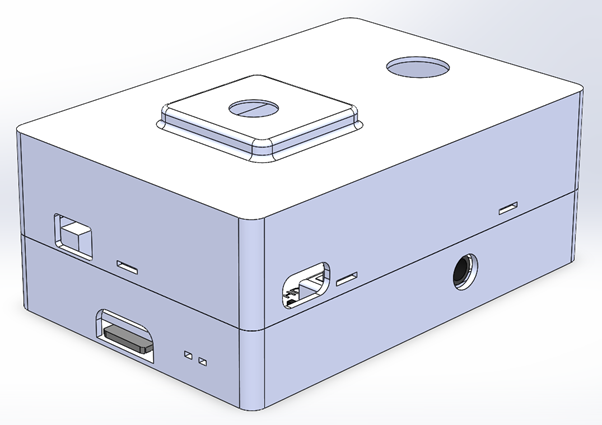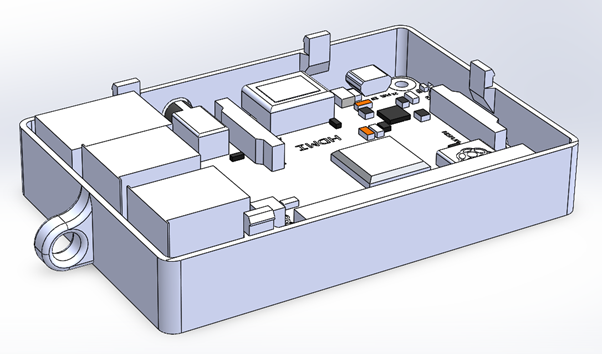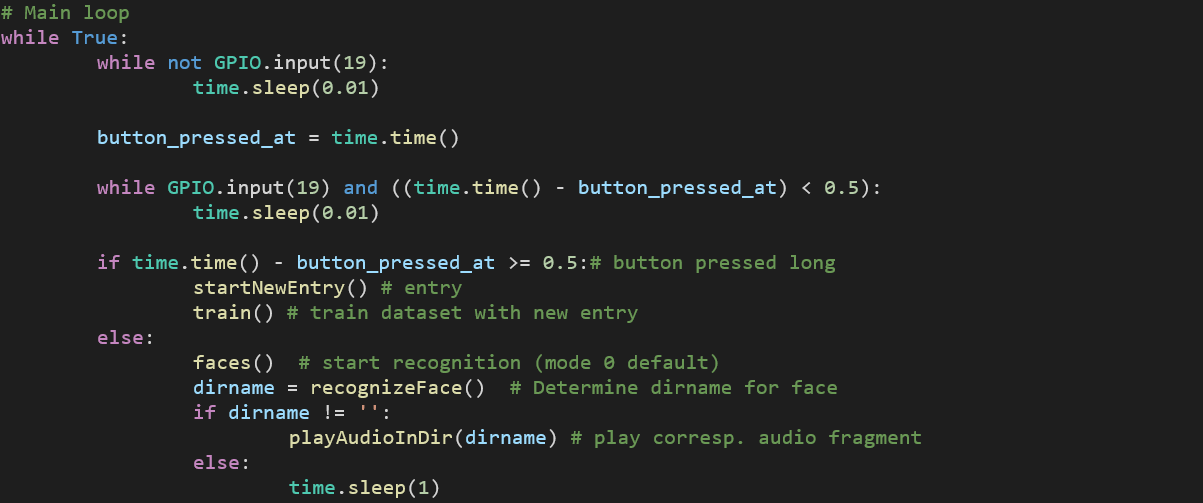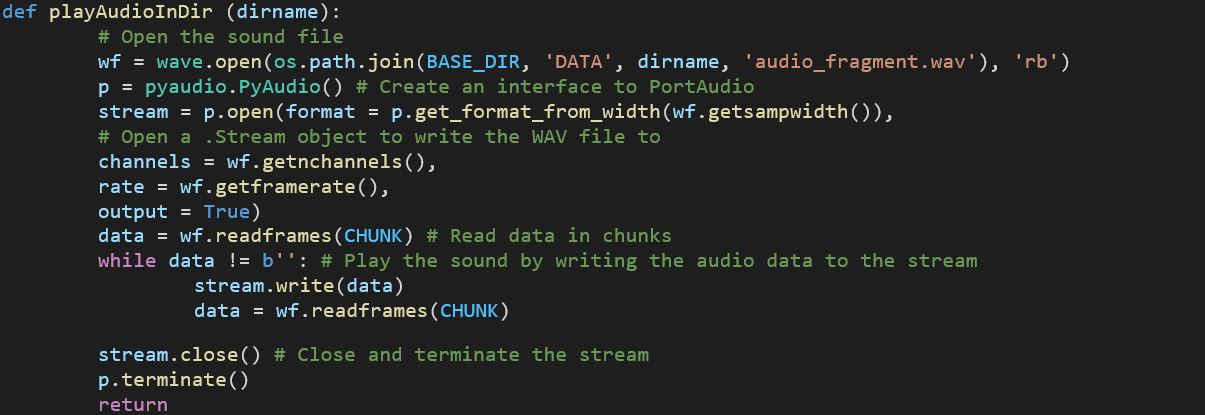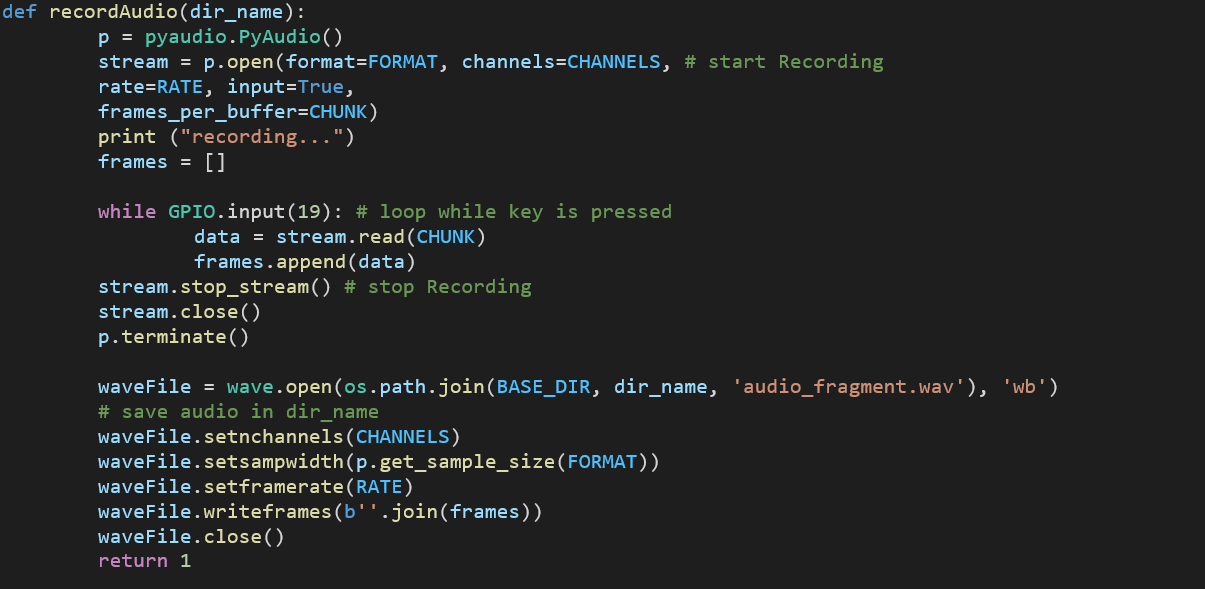PRE2022 3 Group8
| Name | Student number | Study | |
| Matthieu den Otter | 0333626 | Biomedical Engineering | m.d.otter@student.tue.nl |
| Wilco van der Veen | 1021299 | Automotive Technology | w.v.d.veen@studen.tue.nl |
| Fee Noordermeer | 1587404 | Computer Science | f.j.noordermeer@student.tue.nl |
| Sam Lancee | 1640364 | Psychology and Technology | s.l.lancee@student.tue.nl |
| Dave Hannet | 1715666 | Industrial Engineering | d.b.hannet@student.tue.nl |
| Merel Nienhuis | 1721763 | Psychology and Technology | m.n.nienhuis@student.tue.nl |
Introduction
Dementia is a neurodegenerative disorder that affects several cognitive functions, such as memory, thinking, comprehension and language1 because of damage to brain cells. Dementia is a general term that covers different medical conditions, such as Alzheimer's disease 2. Often, dementia affects people of higher age, however, dementia is not a direct consequence of age. Dementia is a progressive disease; many symptoms do get worse over time.
There are different stages of the progress of dementia. The main stages are the early, middle and late stages, also called mild, moderate and severe 3. Often, the first stage of dementia is overlooked because the symptoms, such as losing track of the time and forgetfulness, are not seen as specific to dementia. During this stage, most people can live independently. The most well-known symptom during this stage is memory problems. During the second stage, patients may need more personal care because they experience changes in their behavior and might have difficulties while being at home. Problems with their memory become worse, they may for example confuse close ones with strangers. This may result in people struggling with their emotions because they might get upset about these changes.4 In the last stage of dementia, most aspects of a person's life will be affected. Difficulties with memory, mood swings, physical problems and changes in behavior will arise.
Different technologies are invented to provide extra support in daily life for people who suffer from dementia. For example, different devices for helping with memory problems and socializing are already invented. A lot of people that do have dementia feel like these kinds of technologies are helpful for them and they are willing to use them as early as possible if it will help them.
Because people with dementia often have difficulties with recognizing faces and remembering the names that go with it, also called prosopagnosia, it might be helpful to invent a technology that supports the people with remembering faces of their close ones because it may be very upsetting and frustrating for both the patient and the close ones.
Therefore, in this report, it is explained how a facial recognition device could be an useful tool for people suffering from dementia.
Problem Statement
Worldwide people face dementia, in total 55 million people have the illness and around 10% of the world’s population will face the illness through their aging process (Alzheimer’s Association, 2023). Dementia gravely affects the brain’s cognitive and especially memorial capabilities in a negative way, this influences the brain’s ability to remember names of people that they should know. In the world nearly 285 people are visually impaired, these people often can not see faces well enough to recognize their faces.
There are various stages of the progress of dementia. The main stages are the early, middle, and late stages, also called mild, moderate, and severe (World Health Organization: WHO, 2023). Often, the first stage of dementia is overlooked because the symptoms, such as losing track of the time and forgetfulness, are not seen as specific to dementia. During this stage, most people can live independently. The most well-known symptom during this stage is memory problems. During the second stage, patients may need more personal care because they experience changes in their behavior and might have difficulties while being at home. Problems with their memory becomes worse, they may for example confuse close ones with strangers. This may result in people struggling with their emotions because they might get upset about these changes (What Are the Signs of Alzheimer’s Disease?, n.d.). In the last stage of dementia, most aspects of a person's life will be affected. Difficulties with memory, mood swings, physical problems and changes in behavior will arise.
Different technologies have been invented to provide extra support in daily life for people who suffer from dementia and for those who suffer from visual impairment. For example, different devices for helping with memory problems and socializing are already invented. A lot of people that do have dementia or suffer from low vision quality feel like these kinds of technologies are helpful for them and they are willing to use them as early as possible if it will help them.
Because people with dementia often have difficulties with recognizing faces and remembering the names that go with it, also called prosopagnosia, it might be helpful to invent a technology that supports the people with remembering faces of their loved ones because it may be very upsetting and frustrating for both the patient and the loved ones.
Therefore, in this report, it is explained how a facial recognition device could be an useful tool for people suffering from memory loss and people suffering from visual impairment. The proposed solution is a name remembering aid, which the user will be able to wear or point at the person whos' face they would like to remember. The user will then say that person’s name and the device will then proceed to the person’s face linked to the given name. When the user meets a person they have met before they can recall that person’s name from the device by wearing or pointing the device’s camera at the person in question and thus allowing the device to recognize the face and say their name.
This proposed solution lowers the communication barrier and gives more comfort to people with dementia or who suffer from visual impairment who have difficulty remembering their names. It does this by replacing the need for the user’s brain to store the information of linking faces to names, the memorial action needed to successfully remember someone’s name when you see them, and the function of the eyes to successfully identify someone's face. The solution will come in the form of a discrete device that will consist of the sensory attributes of a camera and a microphone to carry out its function of helping the user remember the names of people they meet.
State of the Art
iCare Interaction Assistant for individuals who are visually impaired
The iCare Interaction Assistant is a device for helping people who are visually impaired during social interactions. In the paper ‘A Wearable Face Recognition System for Individuals with Visual Impairments’ (Krishna et al., 2005) it is said that face recognition is the initial step towards building a comprehensive social interaction assistant that will identify and interpret facial expressions, emotions and gestures. The device is part of the iCARE Interaction Assistant project that started with a focus on supporting initial encounters, allowing a user to initiate social interactions. The goal is to facilitate the subsequent verbal interaction by recognizing and interpreting non-verbal communication, including eye contact, facial expressions, emotions, and gestures.
The iCare Interaction Assistant had a smaller user group: only people who are visually impaired. Our product is meant for people with dementia and people who are visually impaired. The device is more discrete, because the camera is in the bridge of a pair of glasses. The ultimate goal of this device is to help with non-verbal communication. Our product only helps with remembering names and relations.
Google Glass
In the paper, ‘A Wearable Face Recognition System on Google Glass for Assisting Social Interactions’ (Mandal et al., 2014) a wearable Face Recognition system on Google Glass for assisting people in social interactions is proposed. The proposed system works in two modes of operations: local (standalone) and client-server Bluetooth (with a mobile phone) architectures. It is a system that includes multiple face and eye detections and regularized subspace-based methods for training and testing individuals in an unconstrained environment.
In comparison to our product, the proposed system is meant to aid all people in social interaction by recognizing persons and providing personal information. Our product focuses on people with dementia and people who are visually impaired. Our product recognizes persons and only provides names and relations.
It is useful to know that Google Glass is no longer available for consumers, but companies can still purchase Google Glass. Our proposed product should be available to consumers.
OrCam MyEye for blind and visually impaired people
OrCam MyEye is a voice activated device that attaches to glasses. The device can read text from a book, smartphone or other surfaces. It also recognizes faces. OrCam MyEye can help someone shop on their own, or work more efficiently (Ghebali, 2023). In this way the device can help blind or visually impaired people live a more independent life.
This product is meant for people that are blind or visually impaired not people with dementia. The size of the device is a as big as a finger and clicks to a pair of glasses. Our product is more visible because it is not attached to something else and is worn around the neck, and is slightly bigger. This device can do a lot more like reading text it also like our product recognizes faces and gives the associated names. The OrCam MyEye 2.0 price is regularly $4,500. This is very expensive for most people. We think our product can be made a lot cheaper than that.
User
Defining Users
The device that is designed during this project, is designed for people suffering from dementia. It is a device that can hang around the neck of the user. The device includes a camera that detects faces that are across. However, because of the broad understanding of the term dementia, it is important to define the users for the designed device more specifically. It is not possible for every patient to use the device. People that are in a later stage of dementia may have difficulties with understanding how to use the device. Talking more about the stages of dementia, it is possible to say that people who suffer from stage 3 of dementia are not capable enough to use the device. As written before, people with dementia in this stage, are very likely to experience many physical and behavior problems. Examples of these problems are losing the ability to control their muscles, needing help with daily activities and having increasing difficulties with communicating (DailyCaring, 2022).
The device consists of an on/off button and a button that has multiple functions. When this button is pressed shortly, the device will recognize the face in front and will play the relevant audio. When the button is pressed for a longer time, the user is able to record audio and this audio will be saved in the database together with the picture the device had made while the button was pressed. Therefore, in order to use the device, it is important that the user is capable of distinguishing the meaning of pressing the buttons long enough. Because people with stage 3 dementia are experiencing significant memory loss and thus different physical problems, these people are not included in the user group for the development of this device.
Also, people with stage 1 of dementia often do not have the symptoms yet for which the device is designed. The symptoms are, as mentioned before, sometimes even overlooked and problems with recognizing faces do not occur yet most of the time. Therefore, also this stage is excluded from our user group. This means that, for the people that suffer from dementia, only the ones in stage 2 are seen as the user group.
After conducting an interview with caregivers, it was concluded that it is also interesting to include another user group, namely people with a visual impairment. Later on, this will be elaborated more on.
Having a visual impairment means that the eyesight of a person is not the way it should be (University of Pittsburgh, n.d.). If this visual impairment is very severe, it is possible that the person concerned is not able to see anything clear anymore, or even loses parts of the sight until nothing can be seen anymore, also known as blindness. When this is the case, the person is not able to see and thus detect faces. This can be very hard to deal with, especially when they used to be able to do that. This is a sudden big change and again technology can play a role in supporting. An example of a visual impairment is prosopagnosia (Prosopagnosia - EyeWiki, n.d.) and therefore it is reasonable to combine this group with the group defined above. The difference is that people with visual impairments are capable to connect voices with names unlike people with dementia stage 2. However, it still is very useful for people with visual impairments to be able to have a technology that let them hear the name of the person standing in front of them.
Personas
 |
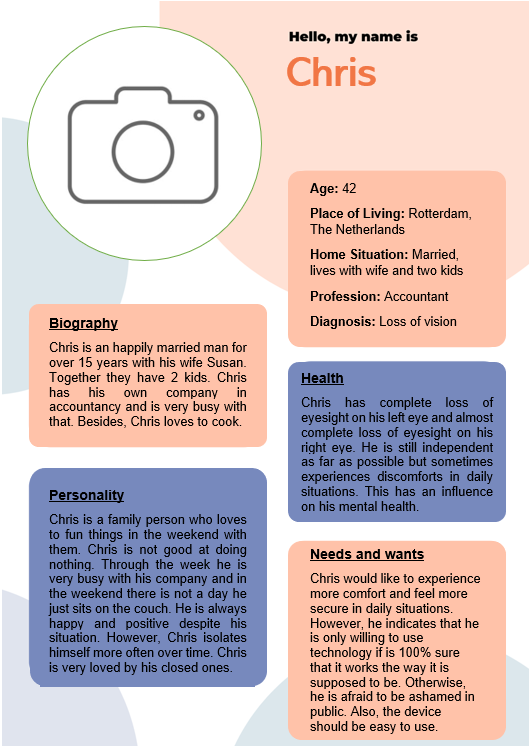 |
Relevance
It is essential to emphasize the relevance of the development of technology. The two main things that need to be reassured are what the needs and wants are of people with dementia and visual impairments and whether these people are willing to receive support from technology.
The personas in image 1 are support for illustrating the relevance reinforced by literature. Looking at the first persona, a person suffering from dementia stage 2 is defined. As written before, the symptoms in this stage include memory loss and less independency (Stages of Alzheimer’s, n.d.). Also, psychosocial symptoms arise such as increasing loneliness and insecurities (Shuman et al., 2017). The question is whether it is possible to offer these people support by introducing technology. It is important that technology is very reliable and will only be used if it contributes to the confidence of the user. People with dementia are willing to use technology as support, and researchers are convinced that this can help (Alzheimer’s Society, n.d.).
Looking at the second persona, problems with vision can cause discomfort in daily situations and often this has an influence on patients' mental health (Protect Your Vision, 2021b). Therefore, it might be interesting again to investigate the positive aspects technology can have. The technology could give more comfort and security to patients, which is already proven. As the social service organization, The Chicago Lighthouse says: “Assistive and mainstream technology has helped and improved the quality of the lives of those of us with visual impairments.” This gives a positive future perspective, however, it is again important to make sure that technology is reliable enough. Otherwise, the patient might be embarrassed to use the device which may not be the case.
Scenarios
Betty
To give a more in depth and concrete view of how our product will help people with dementia in the field, a scenario is illustrated around the persona Betty, an elderly lady living in Eindhoven who suffers from stage two dementia.
It is a Sunday morning and Betty just looked at her calendar and read that her grandchildren are coming to visit her in the afternoon, she is all excited as she loves spending time with them. Betty is however a bit nervous. Last time she saw them she could not remember their names when she greeted them, this problem had occurred multiple times and had really upset her. She had thus decided to buy a name remembering aid which would help her remember their names. Last time when she saw her grandchildren she had used the device to store their names and faces in the hope she would never have to face a situation like that again.
Later that day Betty hears the doorbell ring and gets all excited but also a bit anxious, she thinks to herself: “What if I cannot recognize one of my grandchildren and the device does not either.” She gets and opens the door, her three grandchildren instantly hug her and Charlotte, the oldest of the three, says: “Hey grandma, how are you?.” Betty answers but feels tense as she cannot seem to remember her eldest grandchild’s name. She discreetly presses the button on her new name remembering aid and it discreetly but clearly says “Charlotte.” Betty is relieved and incredibly happy that she knows her eldest grandchild’s name again without having to embarrass or upset anyone by having to ask Charlotte for her name. Betty then asks Charlotte: “Hey Charlotte, would you like a cup of tea? I have your favorite.” Charlotte completely lights up when she hears this as she was a bit taken back last time when her grandmother had forgotten her name.
From this scenario the device lowers the barrier for higher quality interactions between the user and their loved ones and especially comforts the user by assuring them that they do not have to depend on their own memorial capabilities, which might have deteriorated.
Chris
A second scenario is now developed around visual impairment, which will help give a more in-depth visualization of how the device will help this user group. The scenario will be based on the persona Chris, a 42 year old family man with visual impairment.
It is a Monday morning and Chris is having breakfast, Chris is a bit upset as yesterday, when he was cooking, he swapped the names of his two sons Mike and Tom. His sons had pretended not to care but Chris was sure it had hurt them. Luckily, he had bought a new device that day before which would finally help him remember the names of his sons. As he often has trouble distinguishing the people he sees in front of him due to his partial loss of vision. Yesterday he had recorded the names and faces of his two sons with the device, and he was eager to try it out this morning with breakfast.
Chris hears someone come down the stairs and recognizes a small silhouette, "it must be one of my sons" he thinks to himself. There is only one problem, he cannot see which one it is. Chris panics for a minute but then remembers that he has the new name remembering aid. He discreetly presses the button of the device and, to his relief, hears the device quietly say 'Tom'. Chris is relieved and cheerfully says: "Good morning, Tom, would you like some breakfast?". Tom, who cheerfully listens to his father saying his name, replies: "Yes please, I would like some cornflakes". The two continued to have breakfast and a cheerful conversation.
From this scenario it can clearly be derived that the device helped Chris in an efficient way, fulfilling the reason Chris had bought the device. It also proves that the device meets the stated goals when it comes to bringing a viable solution to helping people with visual impairment to remember people's names.
User Requirements
To design the best possible device, it is helpful to think about several requirements the device should have in order to make it the easiest for the user to use the device. Using the MoSCoW-method, different musts, shoulds, coulds and won’ts were thought of. This is displayed in the section MoSCoW analysis. The device should have a camera in order to detect faces and these faces and the corresponding names should be saved in a database.
Looking at the outside of the device, it is very important that the device is user friendly and easy enough to understand. Therefore, it is not useful if there are too many buttons. It is necessary that the device can be controlled and the amount of buttons is limited. This way, it is clear for the user which button has which function and how these buttons should be used.
Another requirement the device should have in order to simplify the use of the device is including a battery that lasts long enough. It would be very inconvenient for the user if the life of the battery is so short, that the device is not able to help the user for multiple hours.
User Needs
Different experience stories show that technology does have the potency to support people with dementia in their daily life. This can be done in different ways, such as providing safety but also keeping the user company (Sauer, 2021).
A woman that does have dementia, faces the difficulty that she starts forgetting the names of the people that are standing in front of her (Duggan, 2022). This makes her insecure, however, a personalized app that is able to recognize people, helps her. As the woman says, it gives her certainty because she is able to have a conversation with someone without wondering what the name is of the person she is talking to.
This shows that technology can give support to people with prosopagnosia, but there should be a few requirements to fulfill the user’s needs. It is particularly important that the device supports the user by giving the user certainty. The device should be a tool that takes away the insecurity of the user for being unable to remember names and thus should be reliable. If the device is not reliable enough, and may for example even say wrong names, the insecurity of the user may even grow. If the device is fully reliable, it allows the user to be more independent and thus gives autonomy.
Concluding, it is especially important that the device that will be developed is reliable. It should not make big mistakes such as telling the wrong names. If it is reliable enough, this will result in more certainty and autonomy from the user.
Stigma
When people buy a device they take in all aspects of it; the price, the aesthetics, the utility, but also how others would view them with the device. In this part of the report we are going to focus on the latter, analyzing how others think they would be perceived with the device.
There are many devices on the market that help with disabilities that people face in their daily lives, like the hearing aid. The first electrical hearing aid was invented in 1898 and has to this day been a popular wearable for people with hearing loss (Systems H., 2019). Research on the stigmatization of hearing aids has been done through multiple studies in the last decades, a recent study done two years ago found that 31% of people wearing hearing aids said that the device made them look visibly disabled (Clinic, E. S. a. H., 2021), 28% said that it made people treat them differently and 34% said they felt embarrassed to wear them in public.
It is expected that our device will be sensitive to the same kind of stigmatic issues and that it might present a barrier for people buying them. To tackle this problem the name remembering aid will be made as discrete as possible so that the chance of it being noticed in public will be narrowed down. Making the device discrete will be a challenge but will be accomplished by the list of things beneath:
- Make the device as small as possible.
- Give the device a camouflage colour, which suits its environment.
- Minimize the audio output so that only the user can hear the device clearly, but people around the user can barely hear it.
- Make the design of the device in a form so that it is easy to put in pockets.
Research also shows that the attitude to the stigma around hearing aids is becoming better (Molly, B., 2021), more people are becoming familiar with it and are understanding it better which is leading to a higher acceptance rate in users. Users are also weighing the medical benefits up higher against the stigmatization negatives, resulting in more people choosing to wear hearing aid devices in public (Molly, B., 2021). It is expected that the name remembering aid will follow the same positive trend as the one made by the hearing aids because the stigma around the name remembering device will be around the same as the one around hearing aids.
Privacy Concerns
Privacy is a hot topic in modern day society, rightly so as we are constantly surrounded with devices that track and store information about us. This has caused a significant impact on the market of electronics, especially ones with cameras and microphones, as people are starting to let the way that electronics handle their privacy influence their buying decisions (De, P. D., 2020). It is thus of imperative importance that when releasing an electronic device, which uses cameras and microphones to scan faces and record voices, that is completely privacy safe and that the data stored on the device can not be obtained by a third party.
There are also multiple laws worldwide that restrict and prohibit certain capabilities of certain devices with cameras and microphones, an example is the ECPA law in the United States of America which was instated in 1968 (Electronic. C., 1986).
The biggest concerns about privacy relating to electronic devices with facial recognition are stated below (European L., 2021):
- Improper data storage
- Misuse of data
- Infringement on individual privacy
- Infringement on freedom of speech and association
- Lack of transparency
- It might become normalized to abuse data privacy
- New advances could make data abuse easy
The solution our device provides to these concerns is to make it a closed environment, meaning all data is stored internally in the device and cannot be extracted (only physically). This means that the device has a common cloud based data base, thus making it impossible to extract information from the device without physically having access to it. The device will also be made to intentionally monitor its environment passively, without the user knowing, this gives the user control on when it wants the device to interact with its surroundings.
The risk of the user abusing the privacy of the surroundings he/she encounters does remain as the user will have psychical access to the device, this could be made harder by encrypting the data collected on the device but it will never be foolproof. It must be stated though that this abuse could be done by any phone in this modern day and age, thus not making the device extraordinarily dangerous when compared to the standard smartphone, and much less dangerous as the name remembering aid is not linked with anything externally opposed to modern day smartphones.
The Goal of the Device
The main goal of the name remembering aid is simple: help the user remember the name of a person they are meeting in a discrete and quick manner without interrupting the social encounter. This will give the user a relaxed and reassuring feeling which will hopefully improve the quality of their daily life.
Prototype
MoSCoW Analysis
| Must |
| have a camera
have a microphone be able to be connected to an audio device (ear, headphones, connected by bluetooth, hearing aid) maintain a database with Images ('faces') and Audio fragments ('names') and (‘relation’) be able to add people to the database have a user button1 pressed for a short amount of time to recognize faces have a user button1 pressed for a long amount of time to record a audio fragment and take a picture to add to the database (photo + audio) have a button2 to switch on/off be easy to use a housing to contain the hardware (easy to wear for instance around the neck) |
| Should |
| be a closed system to protect data
have a rechargeable battery and a device to charge have an indicator for low battery |
| Could |
| have a possibility of changing the audio volume (button3)
send audio output to the hearing device delete people from the database |
| Won’t |
| have a display
be able to edit the database |
Device Description
The device is worn around the user's neck for convenience and ease of use. It has only two buttons, making it user-friendly.
The first button serves a dual purpose. When pressed briefly, it activates the facial recognition feature of the device. This allows the user to identify people in front of them by simply pointing the camera at their face. If the device recognizes the person, it will play an audio clip with the name and relation of the recognized person. This feature is great for people who have trouble remembering names or who frequently encounter new people.
The second function of the first button is to add people to the device's database. To do this, the user holds down the button while speaking the name and relation of the person they want to add. The device also records a picture of the person at the same time. Once the button is released, the device saves both the picture and the audio recording to its database. It then uses this information to train itself to recognize the newly added person.
The second button is used to turn the device on or off. This is a straightforward function that's easy to understand and use.
To realize this device the following hardware was chosen. As it provides a good platform for prototyping.
System Specification
- Raspberry Pi 3 model B+
- ArduCam 5 Megapixels 1080p sensor OV5647 mini camera video module. Angle of View: 54 x 41 degrees
- USB Mini Multimedia Recording Voice Microphone
- Minijack ears connected to Raspberry
- Battery hat
In order to keep within the limited budget the decision was made to use a specific type of hardware that would allow them to test the viability of our concept without spending too much money. While this hardware was a good choice for keeping costs down, it did have some limitations. One of these limitations was that it made it difficult to create a prototype that would combat stigmatization of the device. This is something that would require a larger budget and more time to achieve.
Despite these limitations, we were still able to create a prototype that would provide the desired user experience. We used SolidWorks to create a 3D CAD model of the device's housing, which would house the prototype. This allowed us to design the device in a way that would be comfortable and easy to use for the end user. The final design for the housing can be seen in the pictures that follow.
Housing
After completing the design this housing was made a reality using a 3D printer as it allows for quick and cheap prototyping.
Software
The python script uses the pyaudio library for audio recording. Face recognition is handled by opencv library.
Main functions in the script are:
- def takePicture(dirname) # Runs faces in mode 1 (recording)
- def startNewEntry() # starts recordAudio
Main loop # waits for a button press. If button was pressed long (>.5s) start new person entry, else start recognition and if present, play the corresponding audio fragment.
def recognizeFace() # Runs faces in default mode 0 (recognition) while the face has not been recognized. Exits loops when face is detected OR a key is pressed. Returns corresponding folder name
def playAudioInDir(dirname) # Plays the file ‘audio_fragment.wav’ in folder dirname
def recordAudio(): # Records an audiofragment and stores it in dirname
def train() # training the dataset with newly taken images and audio fragment
def train() function trains the data set with the newly taken images and audio fragment. This first part of the code looks like this:
First it goes to the folder where all the directories are stored that can be found via IMAGE_DIR. In that folder all the directories with their corresponding images and audio fragments exist. It searches for any file that can be an image with the if statement. After that the image is changed to a grey scale because that is standard for the OpenCv library. And finally with the last part of def train():
The face is being detected and the label is added to the id numbers.
def faces(dir_name=’’, mode=0)
# Recognizes a face or store a face in dir_name
# mode 0: Recognize a face and store image.png in parameter dir_name
# mode 2: Take image of a face
In this function the faces are being recognized.
First the face_cascade that comes with the OpenCv is being loaded for further usage.
The video is being captured by using the first in the index, this is the default camera.
Just as in the train function the face should again be detected. After the detection a list is made.
This is done because the detection works quite fast. The faces are being put in a list so the face with the biggest square can be taken. This is the person that is the closest to the camera.
A confidence level is set at if it is between specific values the corresponding label is given. After that the while breaks and the cap is being released.
If the face is not recognized it will draw a rectangle around the face and the name is set to “unknown” so it is easier to distinguish them.
And finally, the window will be destroyed:
For the full code and the files used to support the code everything can be seen in Appendix 3: Code Files, which contains a link to Gitlab.
Testing
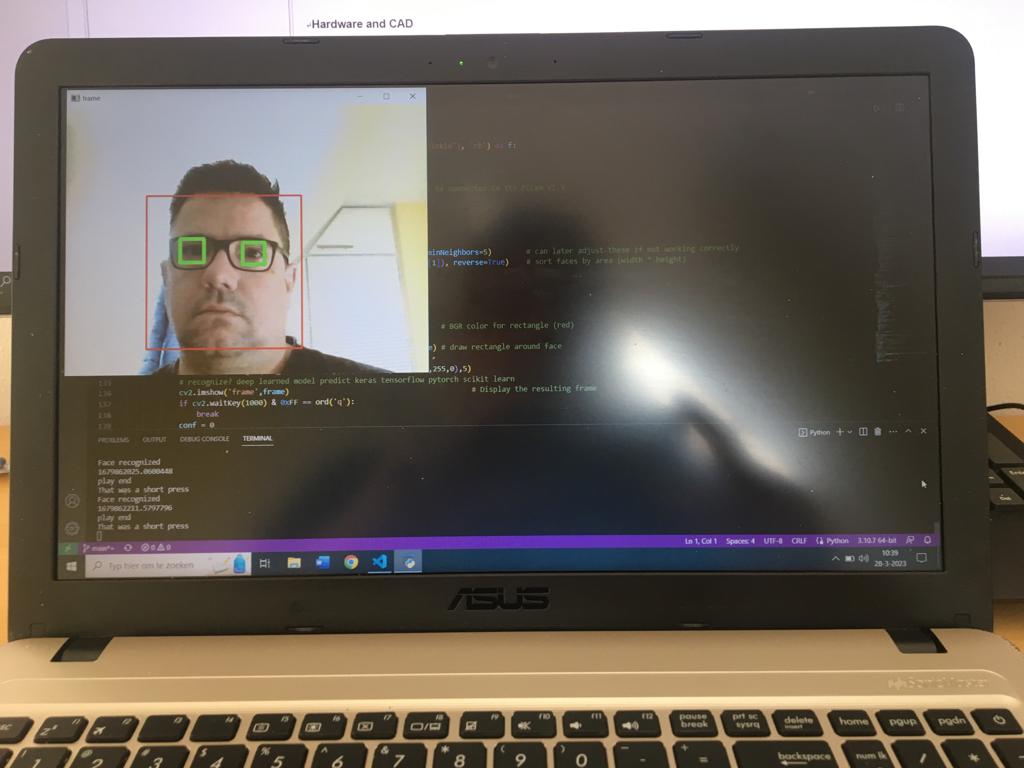 |
 |
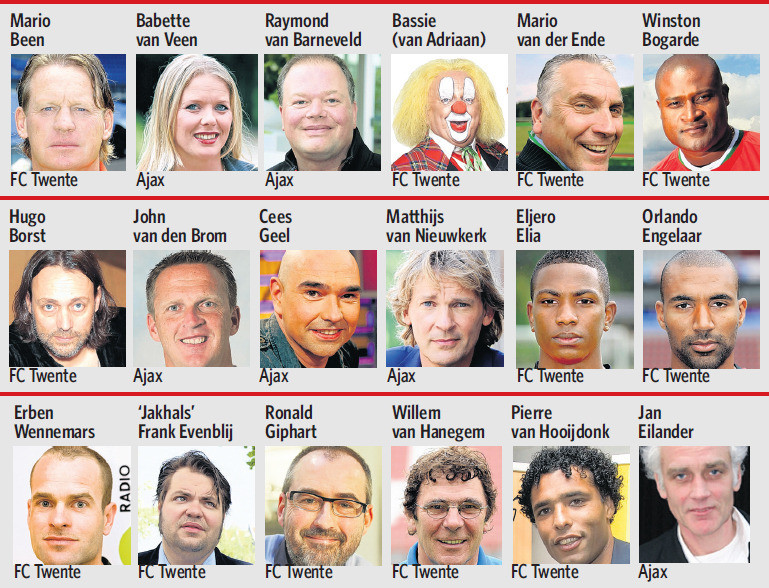 |
|---|
A first prototype was made for laptop. On a short spacebar press the recognition sequence was started in an infinite loop and thus kept recognizing until program was terminated. A long key press started recording sequence.
A test set of 24 persons was entered. In the first test, the same images were shown to the system five times.
In a second test, a different image of the same person was presented to the system.
Scores for first laptop test :
 |
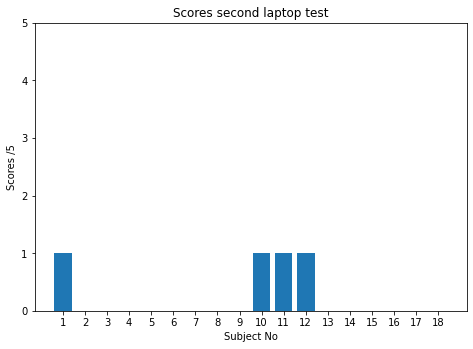 |
|---|
We noticed that if an incorrect recognition occurs, very often the same audio fragment is played. Eg many persons got wrongly identified as Jan Eilander or Orlando Engelaar. This suggests a dominant position for those two persons in the recognition set.
Audio functions are working fine. Audio is well audible. Image captures are being taken properly. Maps (named with timestamp) are being created and corresponding audio/image get stored in the folders.
Each folder contains an audio fragment of approx. 400KB, the image takes approx. 100KB. Total 0.5Mb per entry.
Interviews
Introduction
Besides the literature research it is also important to get feedback on the prototype. With the feedback it is possible to improve our product to become the best version and gain new insights for probable future research. Therefore, people must be interviewed in order to get their input on the current prototype. Since it is hard to find people with dementia that want to participate, we wanted to look at the people that work with people with dementia. That group consists of anyone that has worked in an elderly home and has experience with working with people with dementia. So for these interviews the main research question is: “What are the benefits, shortcomings and challenges in using in our prototype?”
Method
In this study, five participants were interviewed. These participants consist of people who are currently working in the hospital but all have experience in their career with working with people with dementia. Convenience sampling was used to find these participants, simply by walking in the “Universitair Medisch Centrum Utrecht” and asking nurses if they have experience with people with dementia. The group consisted of three men with one around the age of 30 and two around 55, and two women who are both around the age of 50. The interview is performed in a semi-structured way to give the opportunity to explore different themes. After a small introduction about the prototype and some questions regarding their demographics, eight questions were formed as a basis for the conversation, these questions can be seen in Appendix 1: Interview Questions. All the interviews took place in the hospital. For the first interview it was an one-on-one interview in a quiet space and the interview took about eight minutes. The second round was done by asking four people at the same time and this interview took about ten minutes.
Analysis
After conducting the interviews, the notes that were taken during the interviews are transcribed to complete sentences. It was decided to go for a thematic analysis approach because of the importance of finding different themes that can help in answering the research question. This process was done by going over the text and highlight any piece of code that could be important. If a new piece of code was found, it was decided if this part has the same theme as a previously found part. If this was the case, e code got the same colour, otherwise, it got a distinct colour. For example, when asked about any advantages of the prototype the participant said: ”Het is makkelijker of namen te onthouden” and this was marked orange. Later in the same interview the participant said: “Met name goed voor langdurige opname en thuiszorg, daar zie je ze een aantal keer dus zorgt vcor een makkelijke herinnering” which translates to "Especially good for long-term hospitalization and homecare because you only see the patient a few times" and this code got the same colour to form the subtheme advantages. After doing the full analysis, the text got reviewed again to see if all the codes have the best fittings subthemes.
Once all the subthemes were created, we switched to Miro. This is a website to help displaying sticky notes and were you can easily group different subthemes together if necessary. Each subtheme got added to Miro and with all the codes that correspond to it. With all the subthemes, a total of three themes was found. For example, the theme ‘ease of use and communication’ was created after combining the subthemes ‘interaction with nurse and patient’, ‘user friendly’ and ‘audio recording’. Only the codes for the price preference did not got placed in any theme. That is because this theme does not help in understanding and answering the research question.
Results
The full analysis led to the themes: (1) advantages and disadvantages of the prototype, (2) supporting technology and (3) ease of use and communication. All the themes have subthemes, which can be seen in table below. In order to keep the participants anonymized, the quotes that are used will be represented by a number instead of a name.
| Theme | Subthemes |
| Advantages and disadvantages of the prototype | Advantages
Concerns Improvements |
| Supporting technology | Dementia viewpoint towards current tools
Current tools |
| Ease of use and communication | Interaction nurse and patient
Audio recording User friendly |
Advantages and Disadvantages of the Prototype
This theme is the most important because participants mentioned several things regarding the possibilities of the prototype. Within this theme the subthemes are: ‘advantages’, ‘concerns’ and ‘improvements’.
Advantages
The participants mentioned it is easier to remember the name, which can be supported by the following quotes:
Participant 1: “Makkelijker om namen te onthouden.”
Participant 2: “Voor langdurige opname is het namen onthouden handig.”
This translates to 1: “Easier to remember names” and 2:” For long-term hospitalization it is easier to remember names”.
Concerns
Especially the group of four participants had a lot of concerns regarding the prototype. They believed that the target audience is quite small.
Participant 3: “Alleen voor heel beginnende en daarna niet te doen.”
Participant 5: “Te vroeg misschien nog niet nodig.”
These notes say that in the really early stages it is not yet needed but after the beginning stage it become quit hard to still make it work.
Other concerns mentioned were about the button press.
Participant 4: “Lastig om link te kunnen leggen tussen niet herkennen en knop indrukken.”
Participant 2: “Geen idee of ze in staat zijn de knop in te drukken.”
It is said that if people with dementia do not recognize someone’s face and have to realize they must press the button, it might be quite difficult for them and they might not be able to press the button.
Improvements
The participants mentioned that because of the difficulties in pressing the button that the facial recognition should go automatic. That can be seen in the following notes:
Participant 2: “Moet automatisch.”
Participant 4: “Zonder knop en moet automatisch, herhaaldelijk de naam uitspreken is prima.”
These notes say that there should not be a button press but that it should go automatically, it even can be repeated multiple times.
Supporting Technologies
To get a better understanding about how people with dementia look towards such technologies, questions were asked about what the nurses think their viewpoint is and if current tools are used. Both are also the subthemes in this theme.
Dementia Viewpoint Towards Current Tools
The first participants mentioned that they are positive towards technology such as our prototype.
Participant 1: “Heel positief, goede manier om het uit te leggen.”
The other people agreed on that it really differs per person.
Participant 2: “Lastig te zeggen, verschilt heel erg. Voor mensen om hun heen heel prettig.”
Current Tools
Most participants mentioned that they do not know any tools being used for helping people with dementia remembering names, but one participant did mention other tools used to make them at ease.
Participant 1: “Robot en knuffel worden gebruikt om op gemak te stellen, niet iets voor het herinneren.”
Ease of Use and Communication
In this theme participants mentioned several things about how their interaction becomes different, and what can be done to make the device as easy to use as possible. The subthemes that fit this theme are: ‘interaction nurse and patient’, ‘audio recording’ and ‘user friendly’.
Interaction Nurse and Patient
Here the participants said how their interaction would change if the prototype got implemented. They say it is easier that they know their name.
Participant 1: “Makkelijker voor het onthouden van mijn naam.”
Participant 3: “Scheelt in telkens zeggen wie je bent.”
Audio Recording
The participants said it is important to mention in the audio recording for the patient to know who they are. They said that the name is important but also the relation to the person, such as ‘mother’ or ‘friend’, is a good thing to add.
Participant 1: “Naam en functie misschien zelfs ziekenhuis erbij maar dat hangt af van de gradatie van die persoon. ”
Participant 2: “Relatie tot de persoon en jouw naam, het simpel houden.”
User Friendly
A short manual with easy instructions is needed for the people with dementia to understand it according to the participants.
Participant 4: “Korte gebruiksaanwijzing is nodig.”
But also, it was mentioned that the device should not be too small and that this is also the case for the buttons.
Participant 5: “Niet te klein, telefoon formaat en de knop moet ook niet te klein zijn.”
As mentioned before, the only codes that did not get placed in a theme were the codes about the price of the product. All the participants did not have a specific price they would give such a product and believed the device should go via an organization or via their insurance. The full worked out thematic analysis with all the themes, subthemes and their codes can be seen in Appendix 2: Thematic Analysis.
Discussion
In this part of the report, we discuss if the objectives stated in the user parts of the report were met. First, the problem statement is analyzed, when looking at the prototype the basic functions of the device serve the defined problem statement, namely, the device lowers the boundary of the chance that the user forgets a person’s name that they had met before.
The user requirements and needs will now be looked at, when defining these requirements and needs, a MoSCoW analysis was made which would define the needs that the device would address in a functional way. When looking back at this analysis we can conclude that none of the COULD's, WONTs were implemented in the device and the battery life indicator from the SHOULD's was not realized in the prototype. Despite these cuts in the MoSCoW enough of the functional parameters were met to successfully address the prime goal of the device and thus satisfy the user requirements and needs. The device was also meant to be as simple as possible, to satisfy its goal, this was achieved by giving the device only two buttons and a minimal number of functions to make the device as user-friendly as possible for the defined user group.
Stigmatization of the device was a concern for the device as it might create a boundary for potential users to use the device, to counter this the design goals of the device were made so that the device would be as discrete as possible to lower the perceived stigmatization of the device. The prototype measured under the 10cm (biggest dimension), has the colour black and has a box like shape making it as discreet as physically possible and thus achieving the objective of lowering the perceived stigmatization of the device.
Another concern around the device was privacy around the data collected by the device. To solve this as best as possible, it was decided to make the device a closed software device. That means that the audio recordings and images are only stored locally on the device itself. This would help contain the data collected via the camera and microphone and would help protect it. The developed prototype adheres to these whishes as it does not send any of its collected data to any external server and keeps of it all on its internal storage system, thus drastically improving data privacy quality and keeping in line with the privacy goals set previously in the report.
The device prototype thus meets all the predefined functions stated in the MoSCoW and thus has the potential to become a great device in the field, doing all that it promises. It will however be an arduous process to get these satisfactory results in the field as the software associated with the device is hard to perfect so that it does well what it is meant to do. In the next part of the discussion the technical side of the device will be discussed, and the evaluation will be made of how good the device would be in the field and if it is up to fulfilling its role in society.
Now the technical parts of the report will be discussed. The audio quality of the device is sufficient for its purpose. Audio file compression is an opportunity for improvement since it is responsible for 90% of the storage space. The device would currently be able (memory 1GB) to store 2000 entries. Besides the audio recording the current device setting uses an image for the person to be recognized with.
Testing presenting the identical sample image gives better results than sampling with another image of the same person. This indicates that more images of the same person are needed to improve performance. In the current setting, adding an image to a person is not possible. With only one button on the machine, it is impossible to select whose new picture you are taking. This is even more impossible since everyone is named as a timestamp.
However, it is possible to create a new image and audio fragment for the same person. But then a new audio fragment must also be taken, which strongly decreases user convenience and memory management.
Another reason for concern is the 'dominant persons' in the database (as mentioned in testing). It seems a good addition to the device if it would be possible to remove those entries. Also, if a wrong set has been entered, one should be able to remove the entry. With only one button and no visual feedback from the system, this is impossible to implement in a user-friendly way. Entries can only be removed by connecting a keyboard and monitor to the system. This could be implemented in a user-friendly way, in which the person herself or the nursing person can perform these actions. This would take some extra effort, but if these actions result in a well-trained recognition set, that functions correctly it can be worth the effort.
And finally, the interviews are discussed. After gathering the results of the interviews, the research question can be answered. When looking at the themes the most important theme is the advantages and disadvantages of the prototype since that provides the most answers for this study. An important note from multiple participants was that the target audience for this prototype is small. Because either the people are not far enough into dementia and can do it themselves or they are too far from which leads to them having to press the button a lot of times. Although the group is small, they believe they will not feel ashamed and do not mind wearing the device. So, one thing to think about is an expansion of the target audience to reach more people with our prototype. Other challenges are that people might have problems with pressing the button, either because they physically cannot or because they do not realize that by pressing the button, they will know who is in front of them. The main advantage of this prototype is that it can give a name which is convenient not only for the patient itself but also for people who work with them.
For our prototype, it would be great if there was a second version for people in a later stage in dementia. As mentioned by the participants this would mean that instead of pressing the button it will automatically play their names. They also said that this could be repeated and that it would not be a problem for them. If these changes were implemented a bigger target audience would be reached.
There were some limitations in this research, with most importantly the sample size. Only a small sample size was used, and this is not a good reflection of all people that work with people with dementia. It was already seen that the group of four people had similar thoughts, but the first interviewee had different opinions. This could be because of multiple reasons; the group could influence each other into forming one opinion but also the one person could be simply different. To find out results that could be generalized the sample size should be improved. Also, in this research, the interview setting was different because four people got the questions at the same time. For further research, the setting should be identical for each participant to get the best answers.
As the system is now, mass usage would not be responsible because although the device possesses the functions to become a great device for its targeted users, these functions are not calibrated to optimal and would thus not give valuable enough results in the field. Even with improvements, there would still be quite a large fraction of incorrectly recognized people, which would not add a lot of comfort to the users as the device would not really be consistent and reliable enough. With time, however, drastic improvements will be made, and it is feasible that the device could become the envisioned device within a limited time span.
Conclusion
When analyzing the discussion we can conclude several things, namely that all the desired functions stated in the MoSCoW that were deemed essential for the device to work were implemented in the prototype. This is a good thing as these functions are necessary to accomplish the objectives of the device.
Although the device contains the functions that it is meant to have, how well these functions work is another matter. The prototype, at this stage, still achieves results on the lower side when carrying out its functions. From this it can be concluded that the device is not yet ready to be introduced to the consumer market and that it will take some time before the device is optimized for mass use.
Bibliography
Alzheimer’s Association. (2023). Alzheimer’s Facts and Figures Report. Alz.org. https://www.alz.org/alzheimers-dementia/facts-figures#:~:text=More%20than%206%20million%20Americans%20of%20all%20ages%20have%20Alzheimer%27s,older%20(10.7%25)%20has%20Alzheimer%27s.
B. (2015, May 7). How Does Technology Help People Who Are Blind or Visually Impaired? - The Chicago Lighthouse. The Chicago Lighthouse. https://chicagolighthouse.org/sandys-view/assistive-technology/
Clinic, E. S. a. H. (2021, September 13). Why Is There Stigma Around Wearing Hearing Aids? Evergreen Speech and Hearing Clinic | Blog. https://everhear.com/why-is-there-stigma-around-wearing-hearing-aids/
D. (2022, February 7). 3 Stages of Dementia: What to Expect as the Disease Progresses. DailyCaring. https://dailycaring.com/3-stages-of-dementia-what-to-expect/
De, P. D. (2020, March 16). Privacy policies influence consumer behavior online, new study finds | Press Releases | News | Newsroom | DePaul University, Chicago. https://resources.depaul.edu/newsroom/news/press-releases/Pages/consumer_behavior.aspx
Duggan, G. (2022, January 14). This woman can’t recognize her own daughter’s face, but technology is helping her. CBC. https://www.cbc.ca/documentaries/the-nature-of-things/this-woman-can-t-recognize-her-own-daughter-s-face-but-technology-is-helping-her-1.6312174
Electronic Communications Privacy Act of 1986 (ECPA) | Bureau of Justice Assistance. (1986). Bureau of Justice Assistance. https://bja.ojp.gov/program/it/privacy-civil-liberties/authorities/statutes/1285
European Liberties Platform. (2022, October 25). 7 Biggest Privacy Concerns Around Facial Recognition Technology| LibertiesEU. Liberties.eu. https://www.liberties.eu/en/stories/facial-recognition-privacy-concerns/44518
Farnsworth, C. (2022b, November 10). Do people with dementia know they have it? https://www.medicalnewstoday.com/articles/do-people-with-dementia-know-they-haveit#:~:text=Mild%20and%20occasional%20forgetfulness%20is,more%20common%20as%20people%20age.
Ghebali, A. (2023, 4 april). OrCam MyEye - The Ultimate Visual Aid Device for the People With Visual Impairment. OrCam Techologies. https://www.orcam.com/en/myeye2/#:~:text=OrCam%20MyEye%20is%20a%20revolutionary,live%20a%20more%20independent%20life
Krishna, S., Little, G., Black, J. H., & Panchanathan, S. (2005). A wearable face recognition system for individuals with visual impairments. Conference on Computers and Accessibility. https://doi.org/10.1145/1090785.1090806
Mandal, B., Chia, S. C., Li, L., Chandrasekhar, V., Tan, C., & Lim, J. (2014). A Wearable Face Recognition System on Google Glass for Assisting Social Interactions. Lecture Notes in Computer Science, 419–433. https://doi.org/10.1007/978-3-319-16634-6_31
Molly, B. (2021). The Stigma Surrounding Hearing Aids is Changing. https://hearingassociatesmc.com/blog/the-stigma-surrounding-hearing-aids-is-changing
Prosopagnosia - EyeWiki. (n.d.). https://eyewiki.aao.org/Prosopagnosia#:~:text=Prosopagnosia%20can%20have%20multiple%20causes,in%20the%20posterior%20cerebral%20circulation
Protect Your Vision. (2021, September 27). Centers for Disease Control and Prevention. https://www.cdc.gov/visionhealth/resources/features/vision-loss-mental-health.html#:~:text=Loss%20of%20vision%20has%20been,loss%20reported%20anxiety%20or%20depression.
Sauer, A. (2021, May 1). 7 Technological Innovations for Those With Dementia - Alzheimers.net. Alzheimers.net. https://www.alzheimers.net/9-22-14-technology-for-dementia
Shuman, S., Hughes, S., Wiener, J., & Gould, E. (2017, February 28). Research on Care Needs and Supportive Approaches for Persons with Dementia. ASPE. https://aspe.hhs.gov/reports/research-care-needs-supportive-approaches-persons-dementia-0#:~:text=Ultimately%2C%20in%20advanced%20dementia%2C%20people,support%20for%20people%20with%20dementia
Shuman, S., Hughes, S., Wiener, J., & Gould, E. (2017, February 28). Research on Care Needs and Supportive Approaches for Persons with Dementia. ASPE. https://aspe.hhs.gov/reports/research-care-needs-supportive-approaches-persons-dementia-0#:~:text=Ultimately%2C%20in%20advanced%20dementia%2C%20people,support%20for%20people%20with%20dementia
Systems, H. (2019, July 31). The History of Hearing Aids. Hearing Systems | Blog. https://hearingsystemsinc.com/the-history-of-hearing-aids/
Using technology. (n.d.). Alzheimer’s Society. https://www.alzheimers.org.uk/get-support/staying-independent/advice-on-using-technology#content-start
What Are the Signs of Alzheimer’s Disease? (n.d.). National Institute on Aging. https://www.nia.nih.gov/health/what-are-signs-alzheimers-disease#:~:text=Memory%20problems%20are%20typically%20one,the%20early%20stages%20of%20Alzheimer%27s.
What is Vision Impairment? | Department of Ophthalmology | University of Pittsburgh. (n.d.). http://ophthalmology.pitt.edu/vision-impairment/what-vision-impairment#:~:text=Vision%20impairment%20means%20that%20a,objects%20as%20clearly%20as%20usual
World Health Organization: WHO. (2023b, March 15). Dementia. https://www.who.int/news-room/fact-sheets/detail/dementia
Appendix 1: Interview Questions
- Welke voordelen zou het apparaat kunnen bieden aan de gebruiker?
- Hoe staan mensen met dementie over het algemeen tegenover het gebruik van hulpmiddelen?Welke soorten hulpmiddelen worden momenteel gebruikt?
- In welke situaties zou het dragen van het apparaat nuttig kunnen zijn voor mensen met dementie?
- Welke informatie zou volgens jou nuttig zijn om de persoon met dementie te helpen personen te identificeren?
- Welke stappen kunnen worden genomen om het gebruik van het apparaat zo eenvoudig en gebruiksvriendelijk mogelijk te maken voor mensen met dementie?
- Zijn er specifieke situaties waarin het gebruik van dit apparaat niet praktisch of handig zou zijn? (wordt door vraag 2 misschien al beantwoord of stigma effect (Eerst kijken waar ze zelf mee komen voordat ik dit zeg)
- Hoe zou dit apparaat jouw interactie met de persoon met dementie kunnen beïnvloeden?
- Wat voor prijs zouden gebruikers bereid zijn te betalen voor dit product?
English version:
- What benefits could the device offer to the user?
- How do people with dementia generally feel about using assistive devices? What types of assistive devices are currently being used?
- In what situations could wearing the device be useful for people with dementia?
- What information do you think would be useful to help the person with dementia identify people?
- What steps can be taken to make the use of the device as simple and user-friendly as possible for people with dementia?
- Are there specific situations in which the use of this device would not be practical or convenient? (May be answered by question 2 or may consider the stigma effect)
- How could this device influence your interaction with the person with dementia?
- What price would users be willing to pay for this product?
Appendix 2: Thematic Analysis

|
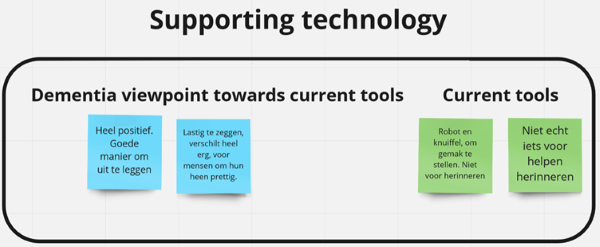
|
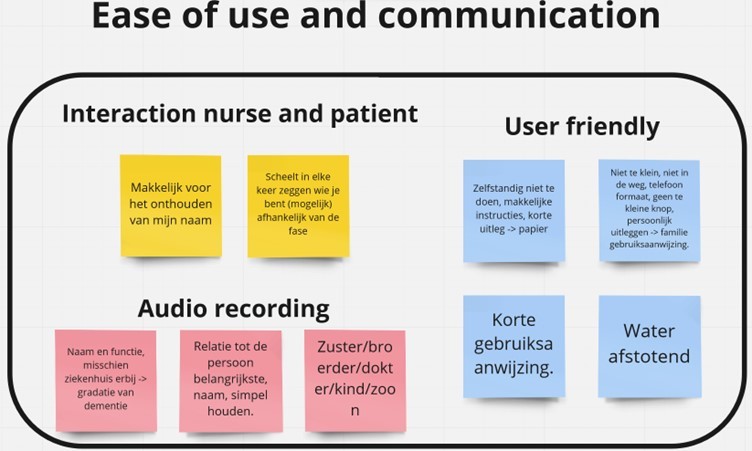
|
